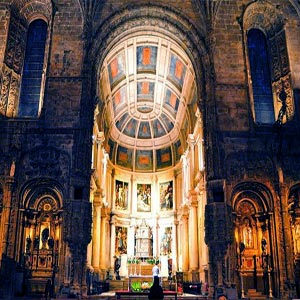A charming calm city with stunning architecture, Trieste is popular as 'the pearl of the Adriatic'. It is located in the heart of Europe. The city's past splendor is evident in its imposing buildings that bear a Neo-classical frontage. Trieste was a part of the Austrian Habsburg Empire and its influence is seen in the Viennese-style cafés and pungent Eastern-Europe cuisine.
Tourists keen on exploring caves and castles would definitely like this beautiful town that has an international repute for its mercantile, artistic and cultural heritage. This city is located on the main trade route, leading to Germany towards the north, Latin countries in the west and to Mediterranean destinations in the south.
Walking around the city is the best way to explore the artistic value of this place. Local road transport is also available. Food lovers would thoroughly enjoy Trieste as the city offers a cultural cuisine that encompasses a wide range of cultures - Savor Caldaia (boiled pork), Jota (soup) and Austrian cakes.
Tourist attractions
Many of the tourist spots of Trieste are found within the medieval quarter of the Old Town. The Basilica di San Silvestro standing atop the Colle Capitolino hill dates back to the 14th-century. Trieste Cathedral is equally impressive. Arch of Riccardo is one of the oldest monuments in the city and dates back to 33 BC.
Museo Revoltella: This museum houses the private collection of Baron Pasquale Revoltella. You can find glitzy chandeliers, gold curtains and gaudy furnishings. There is a collection of 19th-century Italian paintings marble nudes.
Basilica di San Giusto: This Christian basilica has a mosaic of St Justus, Trieste's patron saint. It is a quaint mix of Ravenna and Byzantine styles. The austere façade is juxtaposed with a stone karst canopy.
Castello di San Gisuto: Built atop a hill, the Castello di San Gisuto has a chapel dedicated to San Giorgio. It houses a large collection of suits of armor, weapons and other exhibits.
Castello di Miramare: This castle was built for the Austrian Archduke Ferdinand Maximilian on a large ground the overlooks the cliff on all sides. The park of Miramare houses plenty of tropical species of trees and plants, a blend of typically Northern environment and a Mediterranean context. With a façade of bright Istria stone, the Castello di Miramare offers an imposing view of the Gulf of Trieste.
Piazza d'Unita: This is probably one of the biggest squares in the city and is wonderfully located near the seashore. Flanked by palaces and the Town Hall and the seat of the Friuli Region Government, the Piazza Unita d'Italia is a place for people to hang out in the evenings.
Triesta trivia
- The city has a total population of about 260,000.
- In 1954 the city was divided and the northern zone became a part of Italy while the rest of the territory became part of Yugoslavia.
- Opening of the Suez Canal in the 19th century brought this city closer to the Far East countries and India.
- Trieste was the only seaport of the Austro Hungarian Empire; its free-port status made it an international and cosmopolitan city, and this encouraged multiethnic and multi religious population. The city's harbor is one of the main landmarks within Trieste.
- In the recent past Trieste has grown to be an important center for scientific research in Italy.
- The roman amphitheater built around 2000 years ago in Friuli Venezia Giulia is highly popular among tourists.
- The museum of sea also known as Joyce museum is very famous.
- This beautiful city is frequently battered by the Bora - an icy and powerful north-easterly wind. People now have come to accept it as an inevitable feature of Trieste.
While leaving Trieste do not forget to take back a bit of its culture with you; beautiful paintings, glass work, furniture, antique ware, silverware and lots more.


 Rome Italy City Guide
Rome Italy City Guide Capri Italy
Capri Italy Tuscany Italy
Tuscany Italy Verona Italy
Verona Italy Venice Italy
Venice Italy Paola Italy
Paola Italy Amalfi Coast Italy
Amalfi Coast Italy Naples Italy
Naples Italy Sardinia Italy
Sardinia Italy Vicenza Italy
Vicenza Italy Sorrento Italy
Sorrento Italy Aviano Italy
Aviano Italy Gaeta Italy
Gaeta Italy Ravenna Italy Tourism
Ravenna Italy Tourism Vernazza Italy
Vernazza Italy Trieste Tourism
Trieste Tourism Salerno Tourism
Salerno Tourism Things to do in Genoa
Things to do in Genoa Visiting Florence Italy
Visiting Florence Italy Parma Italy Monuments
Parma Italy Monuments Pisa Tourist
Pisa Tourist Assisi Italy
Assisi Italy Pompeii Italy
Pompeii Italy Siena Italy
Siena Italy Sicily Travel
Sicily Travel










